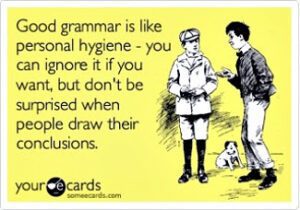Student understanding of grammar is atrocious.
As a teacher, you know what I’m talking about. You cringe at every misspelled word, every comma splice, every uncapitalized “I,” and every dangling modifier.
So how can we help students internalize the grammar instruction we provide?
First, we need to start the year off right. I like to open with a bit of fun, and Weird “Al” really fits this bill.
So I show students Yankovic’s “Word Crimes” video:
Now that we’ve had a little fun, it’s time to get down to business. Research shows teaching grammar concepts separately from the student’s writing process is ineffective at best, deleterious at worst. The most effective way to teach grammar is within the context of student writing projects and through mentor texts.
According to The Role of Grammar In Improving Student’s Writing by Beverly Ann Chin, professor of English at the University of Montana and past-president of the National Council of Teachers of English (NCTE):
As students revise and edit their writing, teachers can provide grammar instruction that guides students in their attempts to identify and correct problems in sentence structure and usage. For example, a teacher who sees that many students are writing sentences containing misplaced modifiers can present a minilesson on this concept, using examples from student writing. The teacher can have students edit their own and one another’s drafts for this problem.
Minilessons
You can find various minilesson sources, including:
[prettyfilelink size=”3 MB” src=”https://www.rethinkela.com/wp-content/uploads/2014/08/COMEBELLICK-GRAMMAR-GUIDE.zip” type=”zip”]Comebellick Grammar Guide[/prettyfilelink]
If you’d like to take advantage of interactive notebooks, especially for tactile learners, I recommend trying Interactive Grammar Notebooks by Lovin Lit at TeachersPayTeachers.com. This unit can be purchased for $13. It will serve as the source for many of my minilessons this year.
Mentor Texts
Mentor texts are important because they show students what quality writing looks like in the real world. According to Kelly Gallagher, author of Write Like This: Teaching Real-World Writing Through Modeling and Mentor Texts:
Beyond teacher modeling in the classroom, my students benefit immensely from closely examining writing from the real world… Yes, it is important to show students how the teacher writes, but it is also of paramount importance to provide students with mentor texts so they can see how other writers compose.
Training students in proper writing using mentor texts is similar to the process used by the Secret Service to train agents to recognize counterfeit money. The Service does not show their agents a bunch of counterfeit bills. Instead, agents extensively study the real thing. That way, they will be able to recognize the real thing — and detect the counterfeits, as well.
Like wise, we must extensively study quality writing from the real world so that students will know it when they see it. Students will also develop a sense for when something is wrong, and through our direct instruction, be able to correct the problems.
The Process
While I’d love to base my grammar lessons solely on student writing and mentor texts, I understand that many students will need to review old concepts and be introduced to new ones in an interactive way. So this is the process I’m going to use this year in order to blend our interactive notebooks with our writing projects.
Introduce the grammatical concept you’re teaching. I recommend starting out with the parts of speech, so that students have a solid sentence foundation. You can use mentor texts to show how authors combine these parts into interesting sentences.
Next, students will need to use what they’ve learned in their own writing. Ask students to write a sentence using the grammatical structure they’re learning about. If necessary, give them a topic to write about. During this process, I’ll also teach students to label the parts of speech by
- Crossing out the prepositional phrases (remind students that we do this because the subject or predicate is NEVER found in the prepositional phrase)
- Underlining the simple subject (always a noun) once, the simple predicate (verb or verb phrase) twice
- Writing “ADJ” over the adjectives and drawing an arrow to the nouns they modify
- Writing “ART” over the articles and drawing an arrow to the nouns they modify (remind students that there are three articles: a, an, the)
- Writing “ADV” over the adverbs and drawing an arrow to the verbs, adverbs, or adjectives they modify
- Draw a crown over the conjunctions. The crown stands for King And-Or-But, from Not-For-So-Yet. This helps them remember all the conjunctions.
- Label the verb “t” if it is transitive, or “i” if it is intransitive
Once we have learned how to label (usually through a daily bell ringer), we can move on to more complex tasks.
Until students have a body of work of their own, or you have gleaned enough examples from their work, provide students with sentences that need to be revised for content. For example, give students this sentence:
The dog barks.
Students must then make the sentence more interesting by adding adjectives and prepositional phrases.
A student might convert the sentences to something like this:
The fluffy white dog barks at the clever squirrel.
Once you’ve done this a few times, give students sentences that need to be corrected for grammatical errors. Students then have the opportunity to function as editors who must identify what is wrong and then make corrections.
If you aren’t sure about the effect that serving in an editorial role has, just take it from the words of a student:
When you’re sure your students have a basic understanding of the process, and are internalizing your instruction, start giving students shorter sentences that they can combine into longer, more complex sentences.
According to Dr. Chin:
Sentence combining is the strategy of joining short sentences into longer, more complex sentences. As students engage in sentence-combining activities, they learn how to vary sentence structure in order to change meaning and style. Numerous studies (Mellon, 1969; O’Hare, 1973; Cooper, 1975; Shaughnessy, 1977; Hillocks, 1986; Strong, 1986) show that the use of sentence combining is an effective method for improving students’ writing. The value of sentence combining is most evident as students recognize the effect of sentence variety (beginnings, lengths, complexities) in their own writing.
When students have a larger body of work to pull from, or when you’re in the middle of a writing project, have students look for short sentences that are closely related enough to be combined. This will help students expand their sentences structure repertoire and writing confidence. You can also use mentor texts to show students examples of more complex sentences. I recommend using Kelly Gallagher’s Write Like This book for mentor text ideas.
P.S. If you’re English Department or PLC is interested in doing a book study, download this guide from Teachers Pondering.
[prettyfilelink size=”136 kB” src=”https://www.rethinkela.com/wp-content/uploads/2014/08/write-like-this-kelly-gallagher-plu-outline.pdf” type=”pdf”]Write Like This Book Study[/prettyfilelink]
You can purchase Write Like This on Amazon.


Excellent, excellent post. I am leading a professional development session this summer for teachers in my district on embedding grammar and stumbled across your fantastic blog. Thank you for your great thoughts!!